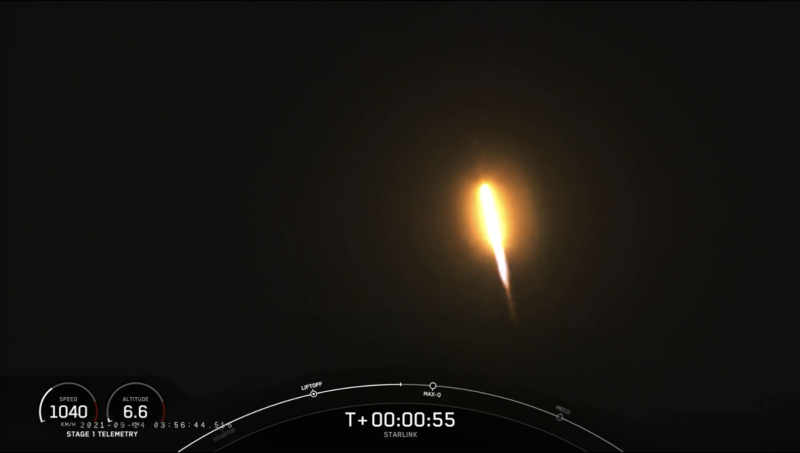
After a multi-month “pause” in Starlink launches, SpaceX has delivered its first 51-strong batch of these low-orbiting internet communications satellites to orbit from Vandenberg Space Force Base, Calif. Liftoff of the veteran B1049 core—making a record-tying tenth flight for a Falcon 9 booster, after nine prior missions between September 2018 and last May—took place from Space Launch Complex (SLC)-4E at 8:55 p.m. PDT Monday. Approximately 15 minutes later, the satellites were deployed on their way to a high-inclination orbit of 70 degrees to the equator. They form the inaugural members of a new Starlink orbital “shell” which will expand internet coverage as far as Alaska and Northern Europe.
B1049’s stellar career over the last three years has uniquely carried it from the East Coast to the West Coast, and back again, twice. She first launched in September 2018 from Space Launch Complex (SLC)-40 at Cape Canaveral Air Force Station, Fla., carrying the heavyweight Telstar 18V communications satellite.
Following this smooth maiden outing, she was transported to Vandenberg, where in January 2019 she lofted the final ten-strong batch of Iridium NEXT global mobile communications satellites to space.
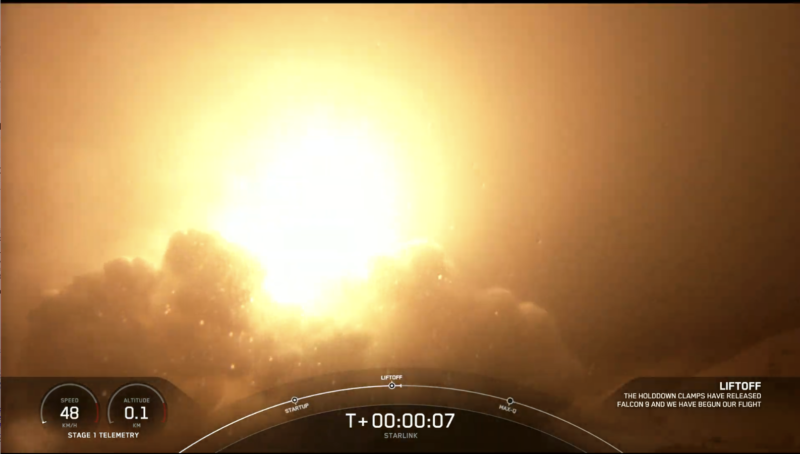
She then returned to the East Coast to complete no fewer than seven missions between May 2019 and May 2021, which ferried a grand total of 418 flat-packed Starlinks into low-Earth orbit. All were inserted into Starlink’s initial operational “shell”, at 53 degrees to the equator. Notably, these missions saw B1049 become the first Falcon 9 core to return safely from a fifth mission and the first to fly a sixth and a seventh time.
Leapfrogged in the most-flown stakes earlier this year by her sister B1051, she currently stands as the second booster in SpaceX’s fleet to have logged eighth, ninth and tenth launches.
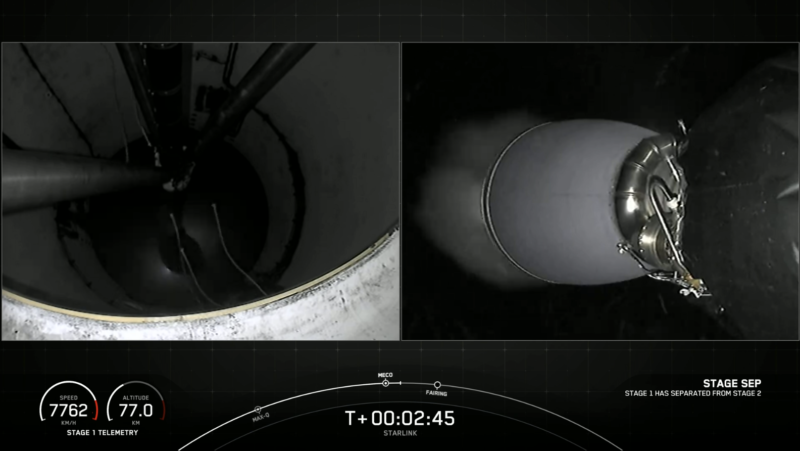
Following her ninth mission last 4 May, she was transported for the second time in her career from the East Coast back to the West Coast, arriving at Vandenberg at the end of that same month.
Also on the move was the veteran Autonomous Spaceport Drone Ship (ASDS) “Of Course I Still Love You”, which wrapped up its 45th East Coast recovery of a Falcon 9 core in early June before being transported via the Panama Canal in July to the West Coast to support future Vandenberg launches.
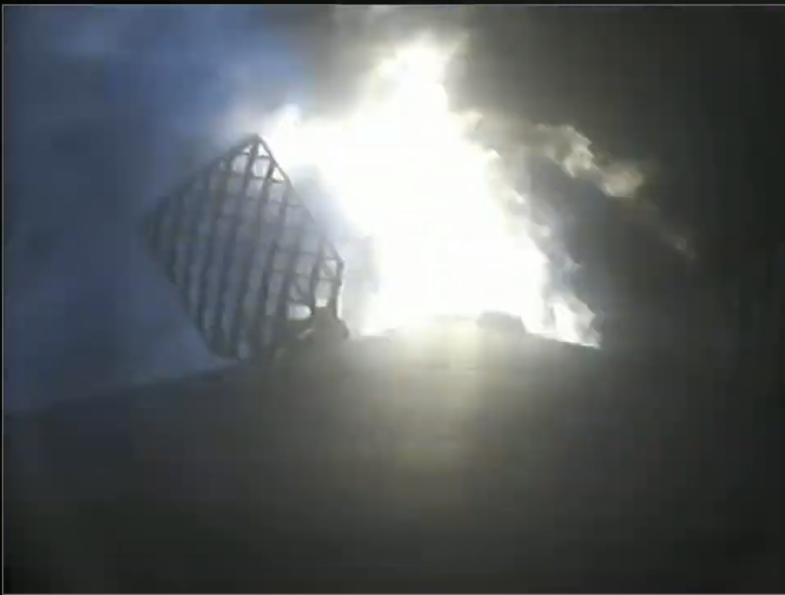
On 2 September, B1049’s nine Merlin 1D+ engines roared to life for a brief Static Fire Test, with SpaceX revealing that the booster was “targeting later this month” for the first Starlink flight to originate from the West Coast. And just last Friday, OCISLY departed the Port of Long Beach, bound for a position in the Pacific Ocean about 400 miles (640 km) off the California coastline.
Early Saturday, SpaceX formally announced that it was targeting 8:55 p.m. PDT Monday for the launch of its first dedicated Starlink mission in almost four months. This “pause” in operations was reportedly due in part to the need to equip all future Starlinks with laser inter-satellite links.
As is customary, fueling of the Falcon 9 got underway about 35 minutes before launch, when a highly refined form of rocket-grade kerosene (known as “RP-1”) and liquid oxygen were loaded aboard the booster. At T-45 seconds, the SpaceX Launch Director issued a definitive “Go for Launch” and the nine Merlins thundered to life at T-3 seconds. Liftoff commands were issued at T-0 and the 22nd Falcon 9 mission of 2021 took flight a little under two hours after local sunset.
B1049 powered smoothly uphill on her tenth mission, her Merlins burning furiously with 1.5 million pounds (680,000 kg) of thrust. The core finally shut down and separated from the stack at 2.5 minutes to begin her descent—precisely guided by hypersonic grid-fins and a series of Entry and Landing Burns—back towards the waiting OCISLY.
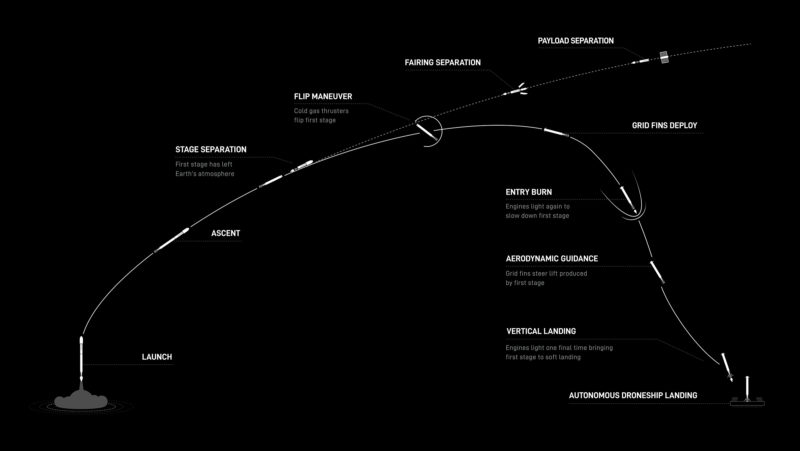
And with sister B1051 having logged nine ASDS landings and a single touchdown on solid ground, B1049 has by default secured the fleet record for the greatest number of “slam-dunks” (ten) on the deck of a drone ship.
With the first stage gone, the Falcon 9’s second stage ignited its Merlin 1D+ Vacuum engine for six minutes to deliver the Starlink payload to orbit. Deployment of the 51 satellites occurred about 15 minutes and 30 seconds after liftoff.
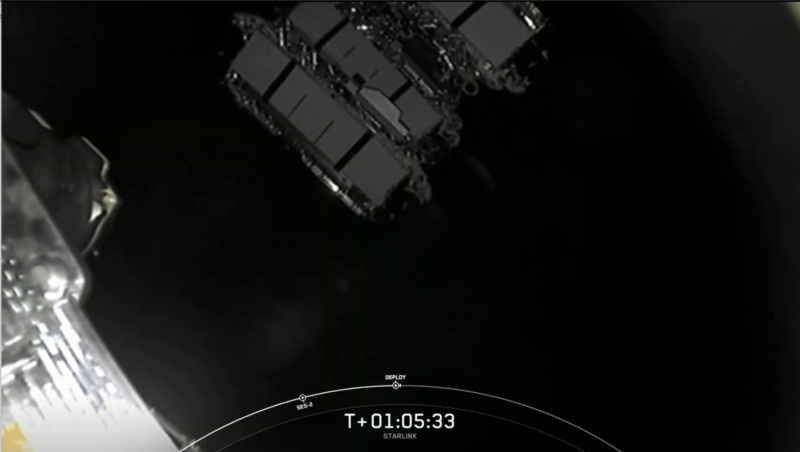
Tonight’s launch represented the first flight of a new orbital “shell” of Starlinks, bound for a high-inclination slot at 70 degrees to the equator and a mean altitude of around 350 miles (570 km), roughly equivalent to the height of the Hubble Space Telescope (HST). This new shell is expected to expand Starlink coverage to higher-latitude locations, including Alaska and parts of Northern Europe.
The $10 billion Starlink program, unveiled by SpaceX founder Elon Musk in Seattle, Wash., in January 2015, is predicted to revolutionize low-cost broadband internet provision, using a network of tiny spacecraft located 60 times closer to Earth than traditional communications satellites.
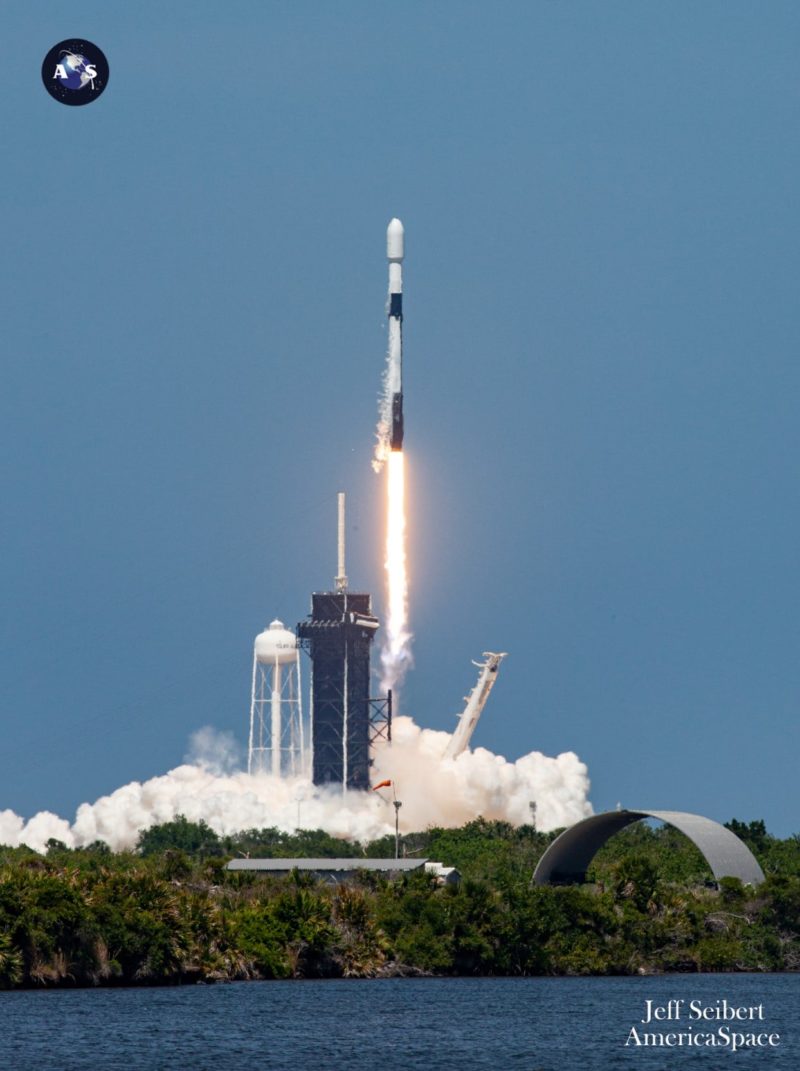
Mr. Musk identified Starlink as a means of opening the way for competitively-priced services to urban regions and underserved areas of the United States and the wider world. Under the initial announced plan, an eventual “constellation” of 12,000 satellites could handle up to half of all backhaul communications traffic and a tenth of all local internet traffic in high-population-density cities by the mid-2020s.
A pair of test-satellites, nicknamed Tintin-A and Tintin-B, were launched in February 2018 and successfully validated Starlink’s phased-array broadband antenna from an orbital perch 320 miles (515 km) above Earth, at an inclination of 97.5 degrees.
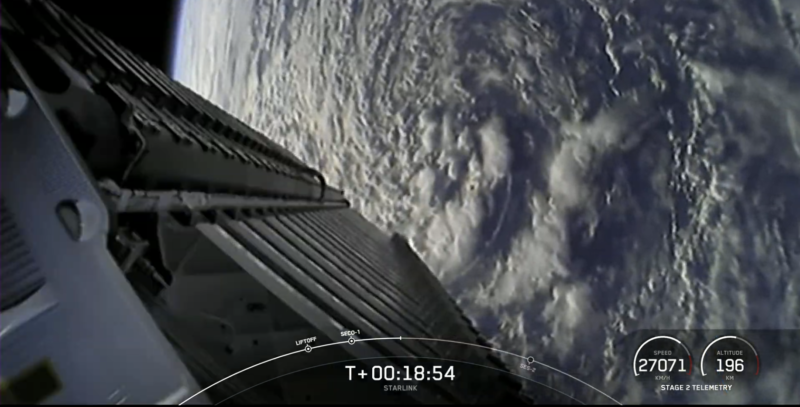
And between May 2019 and May of this year, no fewer than 29 Falcon 9 missions lifted a grand total of 1,725 first-generation v0.9 and v1.0 Starlinks to an altitude of about 340 miles (550 km), inclined 53 degrees to the equator. Additionally, 13 polar-orbiting Starlinks flew as “rideshares” on the Transporter-1 and Transporter-2 missions into slightly higher orbits of 350 miles (560 km), inclined 97.5 degrees to the equator.
With tonight’s launch, the first 51 members of an eventual 720-strong shell of Starlinks are headed for their eventual location at 70 degrees of inclination. SpaceX anticipates getting the 70-degree shell half-done by 2024 and complete by 2027. “These are v1.5 Starlinks,” tweeted Mr. Musk on Saturday, “with laser inter-satellite links, which are needed for high latitudes and mid-ocean coverage.”

With B1049 safely back on terra firma (or, at least for now, terra-drone-ship), attention now turns to the Space Coast, where another Falcon 9—B1062, veteran of two previous launches—stands proud on Pad 39A at the Kennedy Space Center (KSC), with Dragon Resilience primed for the historic Inspiration4 mission.
Having already spent 5.5 months docked at the International Space Station (ISS) between November 2020 and last May in support of Crew-1, Resilience is set for her second orbital voyage, albeit with a very different team of humans and quite distinct mission objectives.
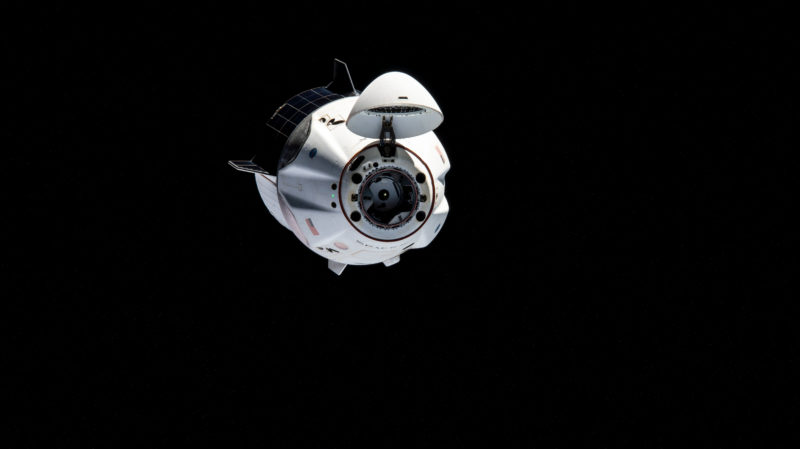
Flying Inspiration4 are 38-year-old billionaire Jared Isaacman, the founder of Allentown, Penn.-based payment processing firm Shift4Payments, teamed with 51-year-old geologist and science communicator Sian Proctor, St. Jude Children’s Research Hospital physician’s assistant and bone cancer survivor Hayley Arceneaux, aged 29, and Air Force veteran and Lockheed Martin data engineer Chris Sembroski, aged 42.
Liftoff is targeted for a five-hour “window”, which opens at 8:02 p.m. EDT Wednesday, after which Dragon Resilience will reach an orbital apogee of over 360 miles (590 km). Current plans are for Isaacman, Proctor, Arceneaux and Sembroski to spend between three and five days in space, before splashing down in the Atlantic Ocean.

The Inspiration4 team—each of whom represents one of the mission “pillars” of leadership, prosperity, hope and generosity—is touted as the first “all-civilian” crew to embark on an Earth-orbital voyage. Although civilians have previously flown on multiple U.S. and Russian missions, they have usually been accompanied by either a military crew member or a non-military “professional” astronaut or cosmonaut.
Back in February, SpaceX announced that Isaacman would command Inspiration4 and donate the three additional seats aboard Dragon Resilience “to individuals from the general public”. Over the course of February and March, firstly Arceneaux and eventually Proctor and Sembroski were selected to round out the crew.
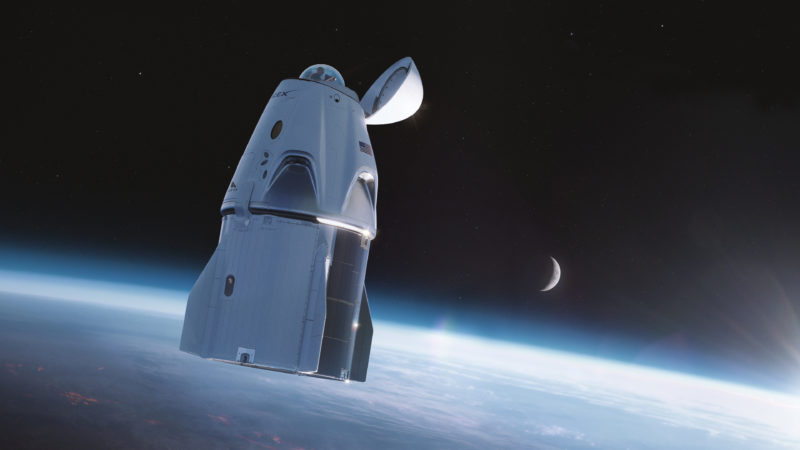
Earlier this month, the Inspiration4 team completed their Flight Readiness Review (FRR) and Isaacman, Proctor, Arceneaux and Sembroski headed from SpaceX’s training facility in Hawthorne, Calif., to the Space Coast.
Last weekend, Sembroski tweeted that Dragon Resilience—set to fly her second orbital trip only 136 days since splashing down after the Crew-1 mission—was in place atop the Falcon 9 rocket in the Horizontal Integration Facility (HIF), near Pad 39A.
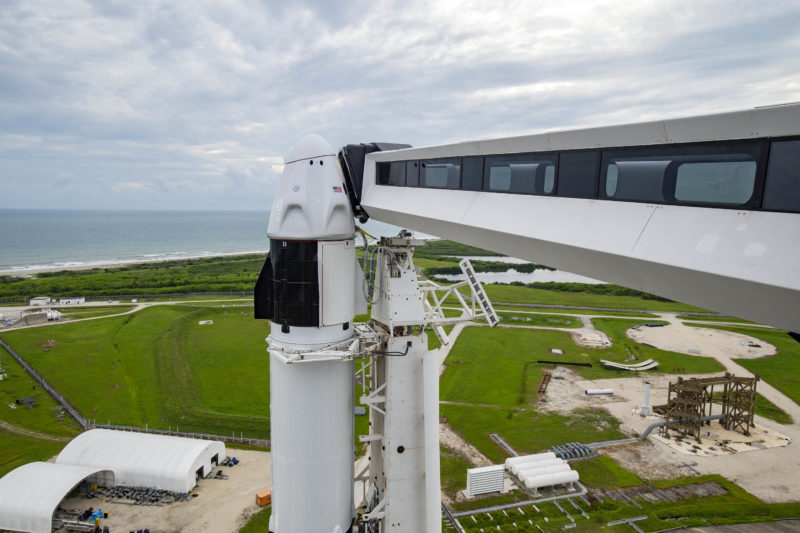
The 230-foot-tall (70-meter) stack was declared vertical on the pad on Sunday and completed a customary Static Fire Test of the nine Merlin 1D+ first-stage engines on Monday. This cleared a final hurdle and enabled SpaceX to announce its intent to target No Earlier Than (NET) 8:02 p.m. EDT Wednesday, 15 September for liftoff.
Weather conditions for Wednesday night and the backup opportunity on Thursday are predicted to be about 80-percent favorable, with a slight risk of infringing the Thick Cloud Rule and Flight Through Precipitation Rule.




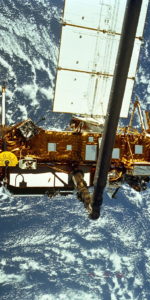

6 Comments
6 Pings & Trackbacks
Pingback:Second 10x-Flown Falcon 9 Launches, Historic Inspiration4 Mission Up Next
Pingback:Crew-3 Arrives in Florida, Readies for Halloween Launch to House Station – AmericaSpace - Technology News
Pingback:Bob & Doug’s Old Booster Restarts SpaceX’s East Coast Starlink Launch Campaign – AmericaSpace
Pingback:Bob & Doug’s Outdated Booster Restarts SpaceX’s East Coast Starlink Launch Marketing campaign – AmericaSpace - Technology News
Pingback:SpaceX Kicks Off First of Three Launches in Three Days – AmericaSpace
Pingback:SpaceX Launches Second Mission in 15 Hours, CRS-24 Up Next – AmericaSpace